In this edition
- A Note From the Editors
- Washoe County Master Gardener Coordinator
- What's Happening This Summer?
- 2024 Philadelphia Flower Show
- An Adventure in Cutting Tool Maintenance
- Bread and Butter (Refrigerator Pickles)
- Beneficial Predators in the Garden
- For These Bees, Nevada Is Home
- What's the Stink About Stink Bugs?
- A Monument to an Insect
- Master Gardener Photos
- Who is This?
- Gratitude
About This Newsletter
Welcome to our newsletter dedicated to gardening enthusiasts in Nevada! Here, the Master Gardener Volunteers of Washoe County are committed to fostering a community of gardening knowledge and education. Through this publication, we aim to provide research-based horticulture insights for our readers. Each quarter, we offer a wealth of information covering various aspects of gardening, from upcoming garden events to advice on topics ranging from pest control to sustainable gardening practices. Join us as we explore the science and artistry of gardening together!
A Note From the Editors
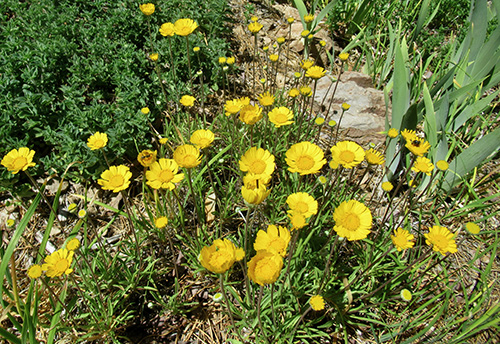
Western sundancer daisy welcomes summer.
Photo by Becky Colwell
Welcome to our summer issue!
Did you know that Nevada has over 1,000 native bee species? Learn some general information about our native bees, their importance to pollination, and how to provide nesting and overwintering sites for them.
Learn to identify more beneficial insect predators, what pests they prey on, and how to encourage them to stay in your gardens doing free, organic pest control. On the flip side, learn how to identify and control stink bugs, a common pest in vegetable gardens.
Have an overabundance of cucumbers? Be sure and try the bread and butter pickle recipe.
Are your pruners, loppers, and other cutting tools getting dull? Find some helpful tips and YouTube videos in An Adventure in Cutting Tool Maintenance.
Take an armchair trip to Enterprise, Ala., to enjoy the boll weevil statues, and then travel on to Philadelphia for the annual flower show.
The Master Gardener program is continuing to provide informational garden talks at the Spanish Springs Library and Rancho San Rafael Regional Park. Interested in gardening for pollinators? Be sure to sign up for the Reno Pollinator Garden Tour. Detailed information about all these events can be found in What’s Happening this Summer.
The Master Gardener help desk is available to answer your gardening questions. Located inside the Extension Office at 4955 Energy Way, Reno, the desk is staffed on Tuesday, Wednesday, and Thursday from 9:30 a.m. to 4:00 p.m. You may also email questions to mastergardeners@unce.unr.edu or phone us at 775-784-4848.
Happy Summer Gardening,
Becky and Chris
Washoe County Master Gardener Coordinator
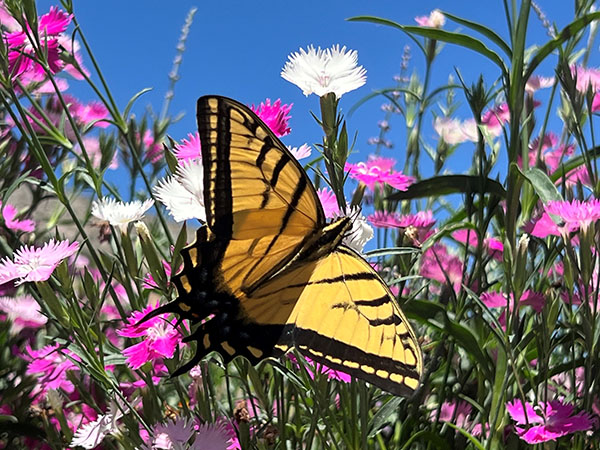
We are halfway through the year and really getting into the growing and gardening season. So much has happened so far in 2024. The University of Nevada, Reno Extension Washoe County Master Gardeners have had so many opportunities to reach out to our community and we are so appreciative of that!
We hand an outstanding seedling sale. Washoe County came out in incredible support of our program. We grow these seedlings in our greenhouse at the University of Nevada, Reno Experiment Station. It is great fun for us to learn so many different growing techniques, but the most fun is knowing that we are growing them for our community, giving them options that we know will do well here. We also donate plants to other places like The Ronald McDonald House, The Northern Nevada Veterans Home, Soulful Seeds and more. We have also started up some of our community educational series talks.
- Spanish Springs Library, Monthly Spanish Springs Library Calendar of Events.
- Rancho San Rafael in the Teaching & Demonstration Garden, Monthly Washoe County Master Gardener Events.
- South Valleys Library: Junior Master Gardener, weekly on Thursdays through June South Valleys Library Events Calendar.
Our Master Gardener Help Desk is also in full swing here at the Extension Office, 4955 Energy Way. The Help Desk is staffed Tuesday, Wednesday, Thursday (except holidays) from 9 AM – 4 PM. We also have mobile help desks for those who cannot make it in during the week. They are located at the Spanish Springs Library and Rancho San Rafael Teaching & Demonstration Garden during the monthly educational events.
Amazingly enough, it is time for the next session of Master Gardener classes! If you or someone you know is interested in the Master Gardener Program, please share. Registration closes in late July. Click the following link for more information: Become a Master Gardener.
I want to send a huge THANK YOU to all the Master Gardeners, who choose to volunteer their time for all these activities.
You all make this a better place to live!
What's Happening This Summer?
Master Gardeners will continue to give short presentations on a wide-range of gardening topics at various locations this summer. A mobile Master Gardener help desk will be available at some locations as well. See Locations, dates, and times below.
Garden Talks at the Library
Where: Spanish Springs Library, 7100A Pyramid Way, Sparks
Talks will be held monthly on the second Sunday from 1 to 3 p.m., and the mobile help desk will be available at the same location from 1 to 4 p.m.
Sunday, June 9, 2024 – in the main library
1:30: Rose Varieties and Rose Pruning for Continuous Bloom: Confused about the different types of roses? Wondering how to prune roses after a bloom to ensure another bloom this season? Come learn all about roses from Master Gardener Georgette Porter.
2:00: Straw Bale Gardening: Heard about straw bale gardening? Wonder if it is something you could do? Join Master Gardener Joan Bonham to learn the basics of straw bale gardening.
2:30: Harvesting Garlic: Did you plant garlic last fall and now you are wondering when you should harvest it? Master Gardener Gary Garrett will teach you about the right time to harvest your garlic and how to cure and store your crop.
Sunday, July 14, 2024 – in the main library
1:30: Bearded Iris - A Stunner for Your Garden: Interested in adding a colorful and textural perennial to your garden? Melinda Gustin, a Master Gardener and landscape historian, will share her experience with this hardy, old-fashioned favorite.
2:00: Common Tomato Problems: Are your tomatoes not producing as well as you’d like? Are you wondering if something is wrong with your tomatoes? Join Master Gardener Deborah Whitehouse as she discusses common tomato problems and strategies to improve your tomato plants.
2:30: Common Pests of the Vegetable Garden: Do you have pests in your vegetable garden? Master Gardener Intern Greta Woyciehowsky will discuss common vegetable garden pest identification and control measures.
Sunday, Aug. 11, 2024 – in the library smart classroom
1:30: Harvesting and Drying Herbs: Fresh herbs are wonderful in the summer, but are you wondering how to harvest and dry herbs for winter use? Join Keri Wilkins, a Master Gardener intern, to learn how to dry and store herbs for year-round use.
2:00: Dividing Oriental Poppies: Oriental poppies in bloom are like having a Georgia O'Keeffe painting in your garden. Their deep taproots make them hard to divide, but they are surprisingly easy to propagate by another technique. Come learn this propagation method with Master Gardener Chris Doolittle.
2:30: Planting Second-Season Crops: Heard about second-season planting? Thinking about giving it a try but not sure where to start? Master Gardeners Shari Elena Quinn and Linda Fulton will teach you the basics of planting for a second season of crops in your garden.
Third Thursday Evening Garden Talks
Where: Rancho San Rafael Regional Park, 1595 N. Sierra St., Reno
Join Washoe County Cooperative Extension Master Gardeners on the third Thursdays in June, July, August, and September for evening garden talks. Talks will be held in the park’s community garden, beginning at 6 p.m. and ending by 7:30 p.m. The talks are hands-on, casual, informative, and free.
Thursday, June 20 Topics
6:00 p.m.: A Nevada Story - The history of Rancho San Rafael Regional Park community garden.
6:30 p.m.: Be Gone Bug - Northern Nevada’s common garden pests.
7:00 p.m.: More Than Just Bees - Pollinators in the garden.
Thursday, July 18 Topics
6:00 p.m.: Beating the Heat - How to protect your plants from extreme heat.
6:30 p.m.: The Trouble With Tomatoes - Common tomato problems.
7:00 p.m.: Cool It - Planning for cool season crops now
Thursday, Aug. 15 Topics
6:00 p.m.: Garden Bounty - What do I do with all my produce?
6:30 p.m.: Nevada Natives - Planting native species in the fall.
7:00 p.m.: Perennial Veggies - Planting veggies that come back by themselves.
Thursday, Sept. 19 Topics
6:00 p.m.: Let it Grow - Using season extenders to keep your crops going.
6:30 p.m.: Night, Night - Putting the garden to bed for the winter.
Reno Pollinator Garden Tour
Come join the UNR Extension and The Biggest Little Bee City USA for a fun and educational in-person event exploring the beautiful world of pollinators! Our Reno Pollinator Garden Tour will take you on a journey through some of the public pollinator demonstration gardens in the Reno area, where you'll learn all about the important role that pollinators play in our ecosystem.
Get ready to marvel at the vibrant colors of blooming flowers, listen to the gentle buzz of bees, and maybe even spot a butterfly or two! Our knowledgeable Master Gardener docents will be on hand in each garden to answer all your questions and provide tips for creating your own pollinator gardens.
Whether you're a seasoned gardener or just have a budding interest in nature, this garden tour is sure to inspire and delight. Don't miss out on this unique opportunity to connect with nature and learn more about the tiny creatures that make our world bloom!
When: Sunday, June 23, 9 a.m. - noon
Where: Various public gardens in the Reno area
To register and receive a map of the tour locations: bit.ly/3K32VnU
2024 Philadelphia Flower Show
Photos and article by Keri Wilkins
The Philadelphia Flower Show, regarded as the oldest and largest of its kind in the world, celebrated its 195th anniversary in March, filling the city’s convention center with color and fragrance for 10 days.
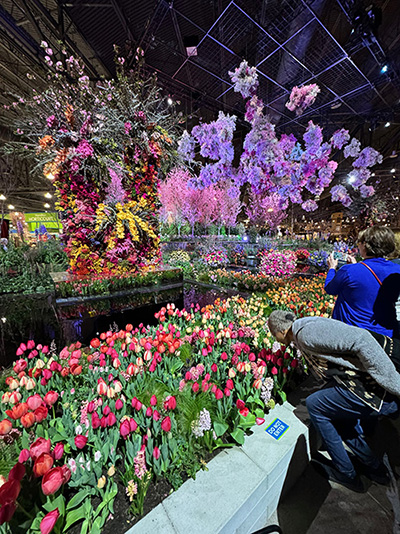
At left, an entrance display 10 to 12 feet tall.
The flower arrangements at the right are hanging from the ceiling.
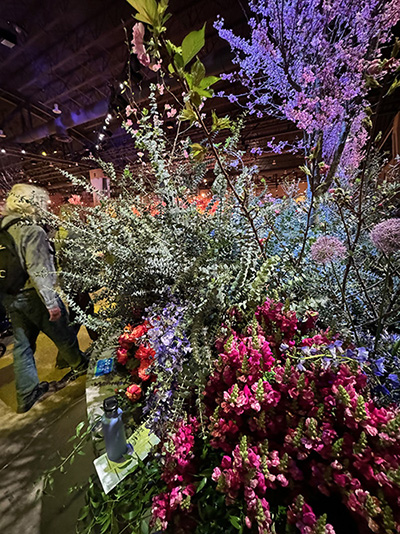
Another entrance display, about 10 to 12
feet tall, showcases various flowers and eucalyptus.
My daughter Pam and I have attended the show annually for over a decade and are always amazed by the sheer size of the displays filling an area of about 32,000 square feet. We attended on a weekday, hoping the crowds are smaller than on weekends, but even on Monday attendance was more than expected.
Attending early in the show’s run has one big benefit: the fragrance of the fresh displays is all-encompassing. I walked in the entrance area and was immersed in the perfume of eucalyptus, roses, and tulips. As we walked around the major displays, we were in a 3-D interactive experience of light, color, and shape. Photos can show some of the floral and decorative beauty and diversity, but the dimensional experience is a completely “in-person” delight.
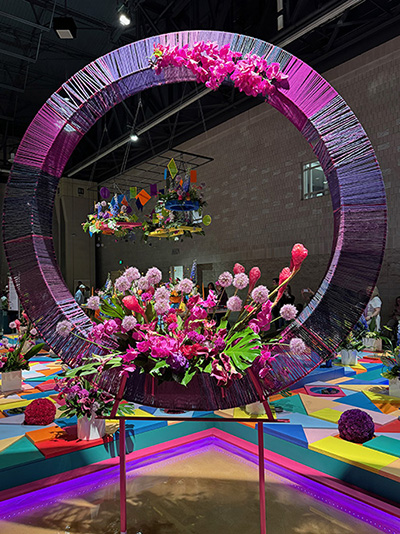
A geometric entry.
The floral spectacle is organized by the Pennsylvania Horticultural Society and is created by hundreds of florists, landscapers, and designers. This year’s theme, United by Flowers, celebrated that community as well as the thousands of visitors who come together to share in a love of gardening, flowers, and plants.
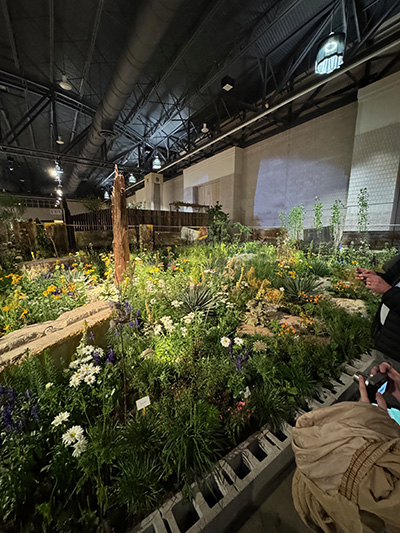
This 30-foot-square display, by Kelly D. Norris,
a horticulturist and landscape designer from Des Moines, Iowa,
depicts an abandoned lot transformed into a wildflower ecosystem.
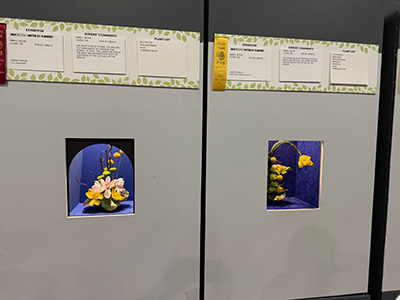
Award-winning displays in the Small Niche flower arrangement category.
I always love visiting the exhibitors to find new seeds, tools, ideas, and handmade swag, but nothing can compare to the floralscapes, some of which cover as much as 3,000 square feet. The show also hosts a major juried competition in horticulture and floral arranging, many gardening talks and demonstrations, special events, a sprawling market, live performances, and plentiful food and drink options.
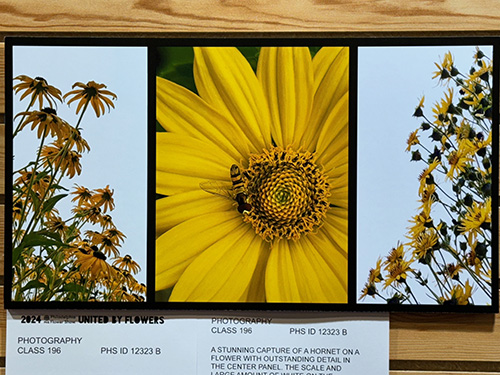
A photography entry titled “Sunflowers and a Wasp.”
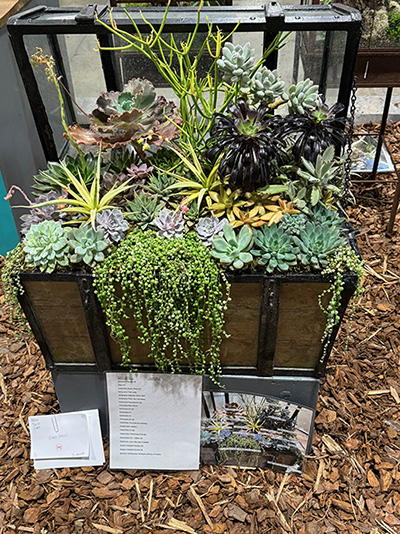
An arrangement of succulents lists the plants
used and identifies them with tags in an accompanying photograph.
I fell in love with dahlias at one of the gardening talks years ago. Garden topics included growing peonies, vegetable gardening, growing herbs for culinary and medicinal purposes, easy houseplants, creating and displaying flowers, succulent gardens and care, and including native plants and wildflowers in your yard and gardens.
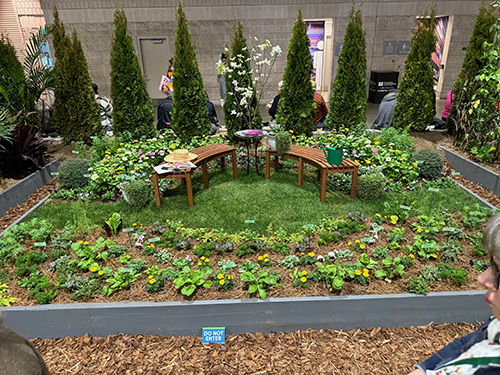
This 12-foot-square display, called “A Garden Room,”
was created and submitted by local high school horticultural clubs.
You can create a flower hat or crown, go to the live butterflies exhibit, pot plants, build terrariums, take show tours with acclaimed horticulturists, and attend “Know to Grow” talks about garden design topics as well as houseplants. Numerous sessions are done by Master Gardeners, too. Tours take you behind the scenes, and show how exhibits are created. There are also tours for small groups before hours, “Fido Friday” tours for visitors accompanied by their dogs, and photography tours led by experienced photographers.
An Adventure in Cutting Tool Maintenance
Photos & article by Rod Haulenbeek
It happens to all of us: time to sharpen and clean those tools we use to cut unwanted organic matter from our landscapes. Here are the ones I have used for over 20 years:
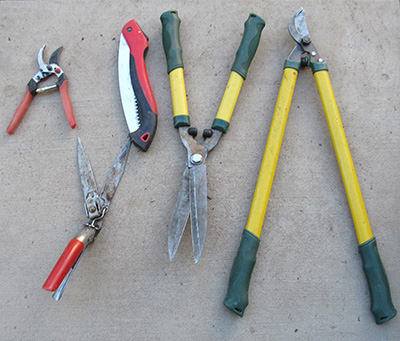
Tools to be sharpened: hand pruners, saw,
hedge shears, loppers and grass hand clippers.
The last time I had these tools sharpened, a couple of years ago, it cost me 90 bucks. I thought that there must be a better way to do this.
So I went to that fount of knowledge (YouTube) to see what other gardeners do. Of course, there were all sorts of ideas. One option was to use a file with fine teeth. So I tried that, and I couldn’t tell much difference after it – the blades didn’t seem any sharper. I figured that the file was not much harder than the blades of the tools, so that didn’t work.
I happened upon a video where the gardener used a device with tiny diamond teeth. I bought a similar device for 28 bucks. The link for this video is: https://www.youtube.com/watch?v=nwLV-Ywar0U. This method worked for the pruners, so I used it successfully on all five tools. Another video said to take off the bolt between the blades, so one could get at the curved blades better. Another video said that one side of the blade was beveled, and to file along and away from the blade. Many of the videos said that one could test how sharp the filed blade was by touching it with a finger. I decided that I just wanted measurable improvement, rather than a blade I could shave with.

Diamond tooth sharpener.
One of the videos said that some people leave their tools outside, where they get rusty. I plead guilty! If the tool is not too rusty, I learned, you can make a paste of baking soda and water, leave it on for a half-hour, then remove the rust with steel wool. Here is the link: https://www.youtube.com/watch?v=nFFiqwKCZvM&t=260s. Another video host mentioned that a really rusty tool might need to be soaked overnight in a very dilute solution of white vinegar and salt in water. Link: https://www.youtube.com/watch?v=DzXfT-J4cL8. I wasn’t that desperate.
The result of my work is shown below in the before and after photos of the shears. Not perfect, but a definite improvement.
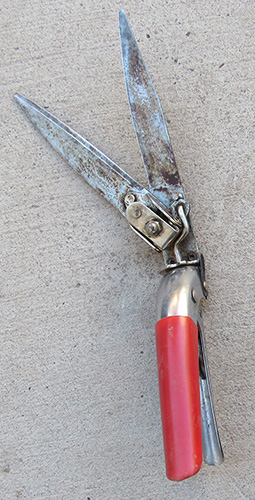
Grass hand clippers before removing the rust.
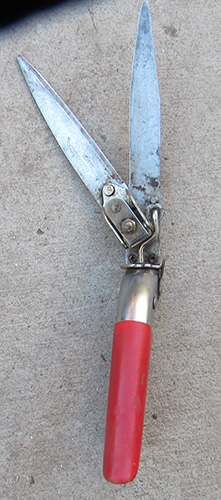
Grass hand clippers after using a paste
of baking soda and water to remove rust.
I also noticed that my pruners had become a little harder to squeeze, and the videos said that the joint in the pruners might need some oil. I got a tube of oil and applied it; this seemed to work.
How long will this take? I estimate it took me two hours, including watching the videos.
The cost? Thirty-five bucks, but these supplies will last for many years.
That’s my story. I hope it might help you in your future.
Bread and Butter (Refrigerator Pickles)
Adapted by Doreen Spires
This recipe was handed down to me by way of my sister-in-law, who got it from her mother (Grandma, as I would refer to her), who originally got it from a teacher she worked with. I have added the green pepper and onions. It’s a delicious way to use garden-fresh cucumbers.
Bread and Butter (Refrigerator Pickles)
- 4 cups sugar
- 1/2 cup salt
- 1 1/2 teaspoons turmeric
- 3 teaspoons mustard seed
- 1 1/2 teaspoons celery seed
- 4 cups vinegar
- 1 sliced green pepper
- 1 onion cut in half lengthwise then in 1/4 - 1/2 inch strips
- 5 to 10 pounds of cucumbers sliced
Heat the first six ingredients to boiling and pour over sliced cucumber, green pepper, and onion. Store in refrigerator several days before using. They will keep all winter.
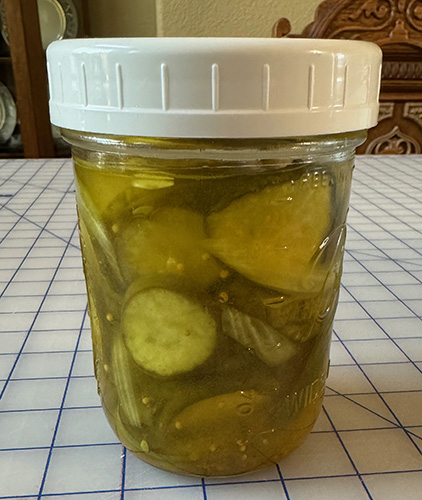
Refrigerator pickles - no hot-water bath required - are
a great way to make old-fashioned bread & butter pickles.
Photo by Doreen Spires
Beneficial Predators in the Garden
Photos & article by Becky Colwell
As the heat increases so does the insect activity in our gardens. But remember: Only 1 percent of insect species are pests. With that in mind, here are a few more good guys to help you keep a lid on your bad guys.
If you have protected sandy areas in your yard, you may have noticed cone-shaped pits in them. These would be the homes of antlion larvae. Antlions belong to the same family (Neuroptera) as lacewings. The larvae, called doodlebugs, prey on many small insect pests, especially ants. Doodlebugs are rarely seen, because they’re hiding in their pits waiting for dinner to drop in. Then the doodlebug grabs it with its mandibles, paralyzes it, and sucks it dry. Antlions can spend up to three years in the larval stage before making a cocoon of sand and silk underground. In about four weeks the adult emerges. Adult antlions are active at night, live about one month, and feed on insects, nectar, and pollen.
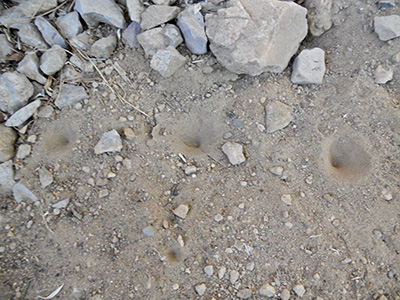
Antlion traps look like cone-shaped pits in protected, sandy areas.
The larvae make these traps to catch their prey, mainly ants that fall into them.
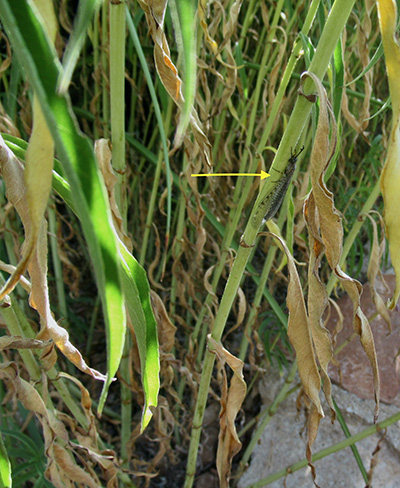
Rare daytime sighting of an adult antlion resting on the
stalk of a Maximilian sunflower (Helianthus maximiliani).
Members of the true bug family (Hemiptera), big-eyed bugs prey on many garden pests including aphids, small caterpillars, leafhoppers, spider mites, thrips, and white flies. Both the adult and nymph stages are predators. They pierce their prey using their needle-like mouthparts, and then suck up body contents. When prey is scarce, they will also eat nectar from flowers. Look for them on plant foliage or in cracks at the soil surface. They overwinter as adults in leaf litter.
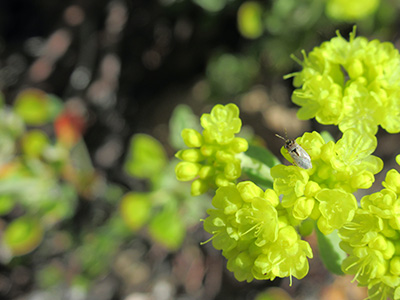
Big-eyed bug on sulphur buckwheat flowers (Eriogonum umbellatum).
The damsel bug is another beneficial in the Hemiptera family. They emerge in mid-summer, and both nymphs and adults prey on aphids, beetle larvae, leafhoppers, caterpillars, and moth eggs. They, too, pierce their meal with needle-like mouthparts and suck up body contents. It is rare to actually spot a damsel bug as they are elusive and can move rapidly when disturbed. Adults overwinter in protected shrubby areas.
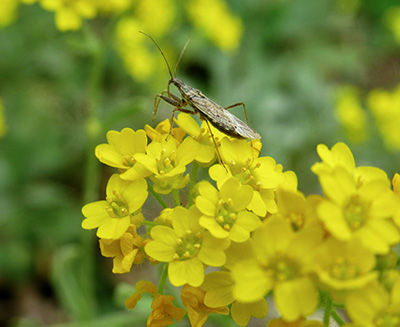
Damsel bug looking for prey on basket-of-gold
flowers (Aurina saxatilis). Notice its piercing mouth part.
Although we do not always appreciate spiders in our homes, they are great to have in our gardens. Spiders are arachnids, not insects, with two body parts and eight legs. But they do a fantastic job of keeping a healthy balance between insect populations in various habitats. Some species, like the orb spiders, weave webs to trap their prey. Jumping spiders stalk theirs, while crab spiders wait in ambush. Spiders’ life cycles have three stages: egg, spiderling (which may involve many growth stages), and adult. The full cycle may take a year, and some spiders can live up to three years as adults. They overwinter in protected areas as adults or egg masses in silken nests.
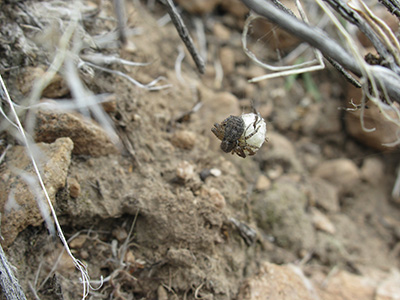
Spider tending to its silken nest, which holds many spiderlings.

Banded garden spider, a species of orb
weaver, wrapping a bee caught in its web.

Crab spider with captured moth.
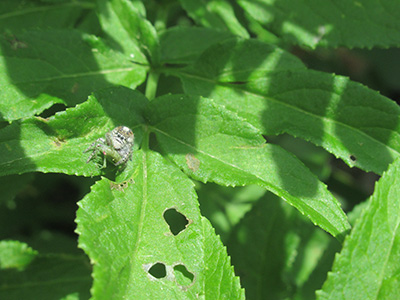
Jumping spider with a captured katydid nymph.
The long-legged fly, which belongs to the Diptera (fly) group of insects, probably goes unnoticed as a beneficial in our gardens. They prey on insect eggs and many soft-bodied pests including aphids, gnats, midges, and thrips. Adults have long legs, are metallic green, blue, or copper in color, and can be found resting on plant leaves in our gardens. The larvae, called maggots, are translucent, white, and smooth. They develop in moist soil or under bark before making their cocoons of soil particles. Long-legged flies have many generations per year and it is believed they overwinter as pupae (cocoons) in the soil and emerge as adults in late spring.
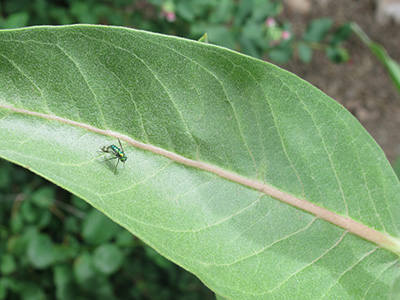
A metallic green long-legged fly resting
on a leaf of showy milkweed (Asclepias speciosa).
Dusk is one of my favorite times to enjoy my garden. I love to watch the dragonflies and damselflies flitting about catching their dinner. Members of the Odonate family, they are ravenous predators feasting on mosquitoes, flies, midges, and gnats. Their bodies are well equipped for aerial hunting, with large eyes for great peripheral vision and spiny legs that catch 90 percent of their prey. And they are expert fliers: Their front and hind wings beat in opposite directions, plus they are able to fly vertically and hover like a helicopter.

The head on this resting 12-spotted skimmer dragonfly is almost
entirely all compound eye, the reason for its great peripheral vision.
Odonates evolved before the dinosaurs, and may have been the first flying insects. Fossil records dating back over 250 million years show that, except for being smaller than their ancestors, the Odonates have remained practically unchanged.
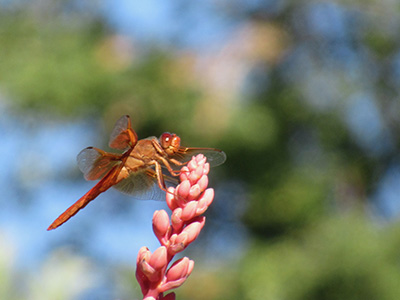
The prehistoric look of a resting flame skimmer dragonfly.
As aquatic insects, odonates spend most of their life in water as eggs, then as nymphs, called naiads. The eggs hatch in three to five weeks, after which the naiads can be partly buried in mud or attached to submerged plants. The naiad stage lasts up to three years depending on the species. During this stage they are busily eating mosquito larvae, other aquatic insects, and even small fish. When the naiads are fully grown they emerge onto land and begin their short life as an adult. Dragonflies may live up to six weeks, while adult damselflies live three to four weeks.
This summer, as the heat and insect activity increases, give these insect predators a chance before resorting to any type of killing agents. It may be a pest to you, but it’s lunch to a beneficial insect.

Aphids are such a tasty meal for many
of the beneficial insects in our gardens.
References:
- Cannon, Cami; Murray, Marion; Patterson, Ron; and Wagner, Katie; “Beneficial Insects of Utah,” Utah State University Extension.
- Zielinski, Sarah; “14 Fun Facts About Dragonflies,” Smithsonian Magazine, Oct. 5, 2011.
- Johnson, Wayne S., Graham, Jessica; and Strom, Sue; “Identification of Common Landscape Pests and Beneficial Organisms in Nevada,” University of Nevada Cooperative Extension, Special Publication 06-08.
For These Bees, Nevada Is Home
Article by Chris Doolittle
Photos by Becky Colwell
It’s a common question at the Master Gardeners help desk in Reno in the early spring: The weather has turned warm, fruit trees are in bloom, and a worried gardener has an urgent query: “Where are the bees? I haven’t seen a single one.”
There is ample reason to worry about honey bees, which have been beset in recent years by a catalog of problems: diseases, fungus, mites, pesticide poisoning, and a mysterious malady called colony collapse disorder. But gardeners in the Reno area who haven’t seen any bees are maybe just not looking hard enough.
Of the planet’s 20,000 or so named bee species, around 4,400 are native to the United States and Canada. Notably, the honey bee (Apis mellifera) is not among them. It came over with the colonists in the 1600s.
But Nevada gardeners have no shortage of local help. More than 1,000 bee species have been found in the state. By contrast, the entire United States east of the Mississippi has only about 700 known species.
The natives have several advantages over the honey bee:
- They’re better pollinators, as much as 300 times more efficient than honey bees. Some farmers are even trying to attract native bees to augment their imported honey bees and increase their yields.
- The vast majority are nonaggressive. Native bees are mothers, not soldiers. They’ll sting if threatened, but mostly they’re fixated on nourishing their offspring, not gathering pollen for the colony.
- Except for bumblebees, native bees are solitary dwellers, making their nests in wood, plant stems, or underground tunnels, which makes them less vulnerable to some diseases and predators.
- Best of all, they’re attuned to Nevada’s environment, so they’re more likely to be available just when you need them. In all likelihood, they’re living in your neighborhood, probably even in your yard.

A black mason bee in a wild four o'clock.
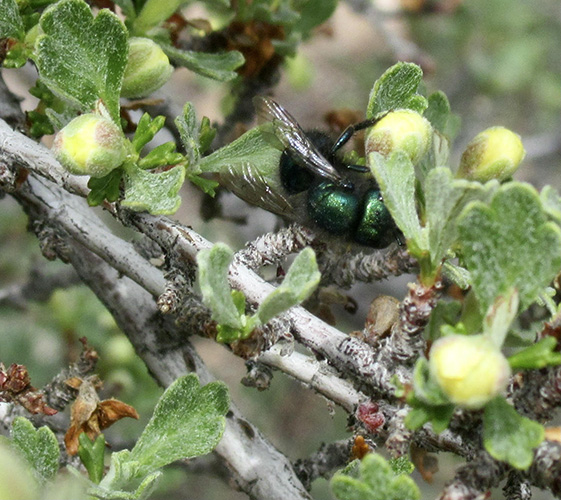
An iridescent green mason bee foraging in bitterbush.
So how do you know it’s a native bee? Close observation. Many superficially resemble the honey bee, with striped abdomens and pollen sacs on their underbellies or legs. But others, like the mason bee, from the genus Osmia in the family Megachilidae, may be black (O. nigriventris), or metallic blue or green (O. lignaria). You may mistake them for a large house fly buzzing your flowers.
The sweat bee (Agapostemon texanum, from the family Halictidae) is a small bee, either all neon green (female) or with a green head and thorax and a striped abdomen (male). They are nonaggressive when undisturbed, but as the common name suggests, they are attracted to sweat because of the salt it contains. The female may deliver a mild sting if you try to slap her off your arm. The male sweat bee, like most male bees, has no stinger.
The leafcutter bee, a close relative of the mason bee, is about the size of a honey bee but has white stripes across her abdomen rather than yellow or buff. If you don’t see her in your garden, you may see her handiwork. She uses a jaw-like structure in front of her mouth to cut round holes in leaves, which she uses to line her nest and enclose the pollen balls and eggs she deposits there. In my garden, she prefers roses and echinacea, leaving almost perfectly round holes in the leaves (it doesn’t hurt the plant).

A western chokecherry after a visit from a leafcutter bee.
Nevada even has its own bumblebee (Bombus nevadensis), along with about two dozen other bumblebee species. Unlike most native bees, bumblebees do live communally, in a colony that generally holds only a few hundred individuals as opposed to as many as 50,000 in a honey bee hive.
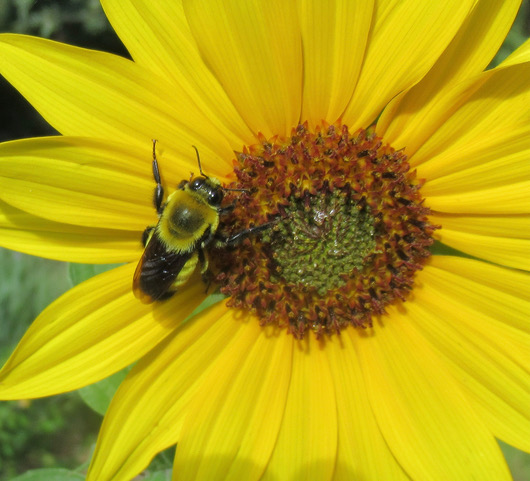
Bombus morrisoni. Bumblebees are early spring risers.
Although Nevada is rich in native bee species, that doesn’t mean it is immune from the problems that plague honey bees. Loss of habitat is a major concern, as is competition from nonnative species, climate change, and pesticide use. In return for all they do for us, it seems only fair to show these bees some hospitality, and nothing could be easier. The best assistance, in fact, may be doing nothing at all.
First, don’t be in a rush to get the garden all ship-shape before the season begins. Your local pollinators may still be asleep in the stems and litter you’re carrying off to the trash, or in tunnels beneath the soil you’re digging up. Bumblebees and mason bees are about the earliest to wake up, in early- to mid-March. Mining bees and carpenter bees won’t be stirring until late March, and some species of sweat bees are still snoozing into May.
Second, don’t get carried away with the mulch and ground cover. Seventy percent of native bees are ground nesters, creating burrows in the soil. They can’t nest in heavy mulch layers, bark, or turf grass. Bare ground is best.
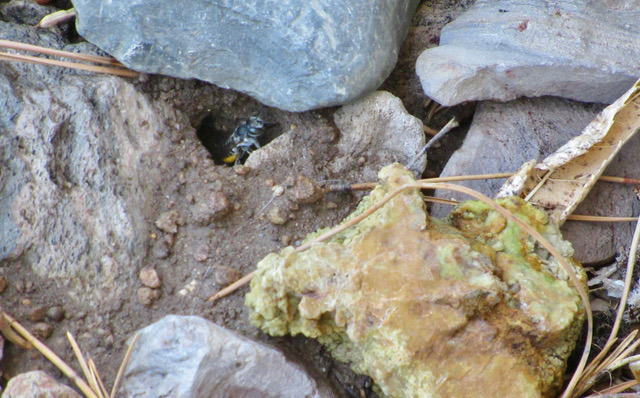
A leafcutter emerging from her underground burrow.
And last, grow flowers. Lots and lots of flowers, whether on ornamental plants or veggies. Spring bloomers, summer bloomers, fall bloomers. You can count on the native bees to be here in the spring, probably well before you see your first honey bee. But don’t forget they’ll be here all year.
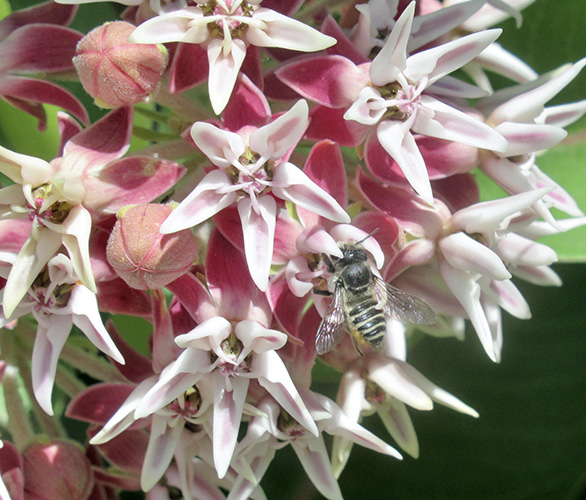
Showy milkweed is not just for butterflies.
What’s the Stink About Stink Bugs?
Photos and article by Becky Colwell
Stink bugs are common pests in our gardens, eating leaves, stems, and fruiting parts of plants. They belong to the order Hemiptera, and can be identified as true bugs by the crossed wings that form a triangle shape on their backs. They get their common name from a smelly odor, a defense mechanism, that is released from glands on their thorax. They are also referred to as shield bugs because of their body shape, like the shields used by medieval knights.
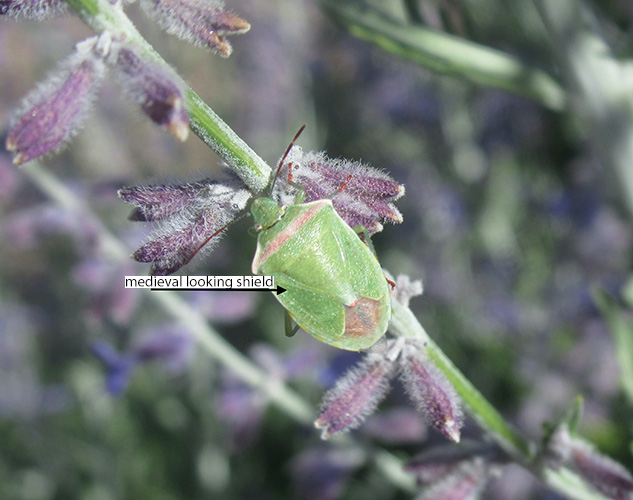
Adult red-shouldered stink bug (Thyanta spp.)
on Russian sage. Although stink bugs come in many different
colors, all adultscan be easily identified by their shield-like shape.
The stink bug life cycle consists of three stages: egg; several stages of nymph, called instars; and adult. Barrel-shaped eggs are laid in groups on plant stems or the underside of leaves. When the eggs are ready to hatch, a smiley face can be seen on them. After hatching, the first-instar nymphs feed on the egg mass, which contains a mixture of symbiotic protozoans and bacteria. Plant material can be difficult to break down, and this mixture enables the nymphs to digest their food. Nymphs leave the egg mass after their second-instar molt.

A cluster of barrel-shaped stink bug eggs on the bracts under a
black-eyed Susan flower. A few eggs have already hatched. Notice
the smiley face on the eggs ready to hatch.

A cluster of second-instar
nymphs on the leaf of a showy milkweed.
Stink bug nymphs go through five instars in four or five weeks before becoming adults in late summer, when their population peaks. During the instar stage, their body is more rounded, lacks wings, and does not have the same coloring as the adult. Nymphs also may lack the distinctive shield shape of the adults.
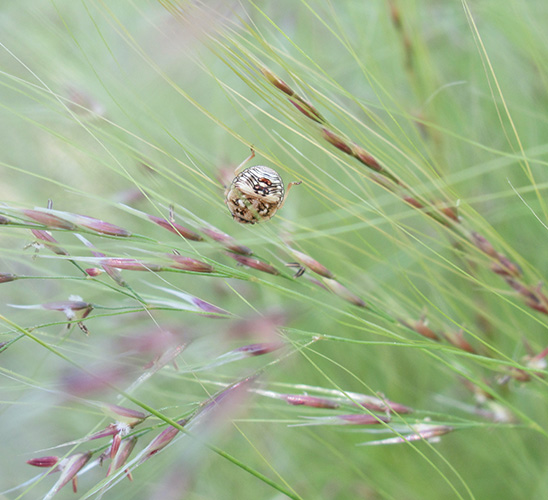
This red-shouldered stink bug nymph
does not have the same coloring as the adult.
Also, notice the rounded body and lack of wings.
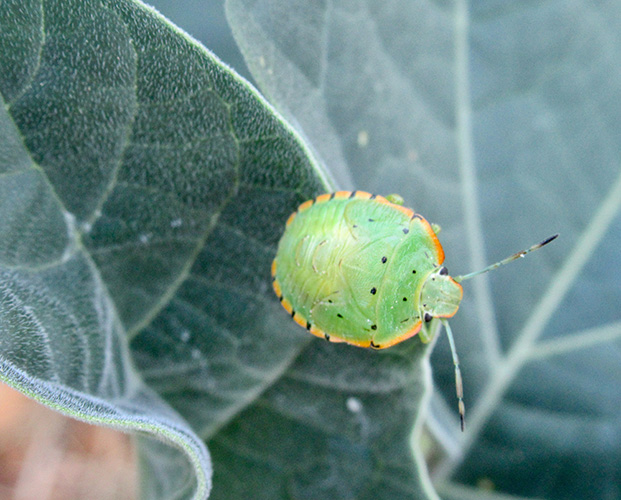
A green stink bug nymph (Chinavia hilaris)
in mid-summer, probably in its fourth instar.
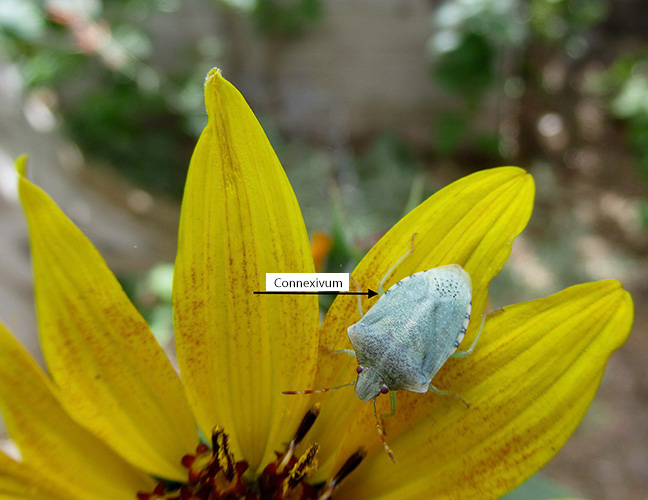
Adult green stink bug. They have a uniform
green body coloration with yellow and black bands
on the flattened lateral border of the abdomen (connexivum).
Adult stink bugs overwinter in plant debris, weedy areas, and under leaves. When they emerge in late spring or early summer, the females begin laying their egg clusters. Depending on the species, they may complete one to two generations per year.
Both the nymph and adult stages are pests. They suck plant sap from leaves, fruit, buds, or blossoms using their piercing, straw-like mouthparts. Below are some symptoms of stink bug feeding:
• Cloudy spots on fruit: white on young fruit or yellow on mature fruit
• Misshapen or shriveled fruits and seeds
• Rolled, wilted, or stunted leaves
• Pimples or wart-like growths on okra and bean pods.
Stink bugs can be found on fruits, vegetables, and ornamental plants. They especially like apple and peach trees, as well as beans, corn, and tomatoes. Hand-picking is an effective control method. Look for nymphs and adults in the cool morning before they become active, and check the undersides of the leaves for egg masses. Pick adults and nymphs off plants and drown them in a bucket of soapy water. If you find egg masses, snip the leaf off, put it in a sealed bag, and throw the bag away.
Natural predators of stink bugs include birds and spiders. Predatory insects include wheel bugs, assassin bugs, and parasitic wasps. A few species of parasitic wasps, one being the Samurai wasp (Trissolcus japonicus), attack the eggs. The rough stink bug is considered a “good” pest as it feeds on soft-bodied caterpillars and beetle larvae.
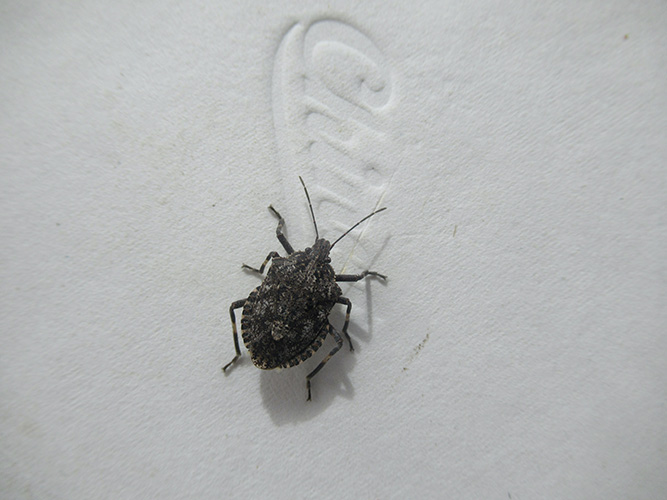
Adult rough stink bugs have a spotted light gray and
black/brown body coloration. Each leg has two light-colored
bands with alternating black and light gray/tan bands on the connexivum.
References
1. Utah State University Extension and Utah Pest Diagnostic Laboratory; “Common Stink Bugs of Utah,” ENT-209-19, June 2019.
2. Borror, Donald J. and White, Richard E. “A Field Guide to the Insects of America North of Mexico,” 1970, Houghton Mifflin Company Boston.
3. Hadley, Debbie. “Stink Bugs of Family Pentatomidae.” ThoughtCo, Aug. 26, 2020.
4. Utah State University Extension; “Stink Bugs,” Utah Vegetable Production and Management Guide.
5. University of Maryland Extension; “Stink Bugs on Vegetables,” updated March 2023.
A Monument to an Insect
Photos & article by Liz Morrow
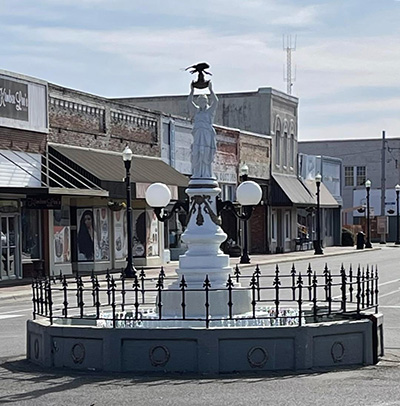
The original boll weevil memorial statue,
erected in 1919. The woman initially held a fountain
above her head. It was replaced with the weevil 30 years later.
In January I was visiting family in Enterprise, Ala., and noticed for the first time some interesting statues. They were renditions of boll weevils, adorned in various work uniforms.
As Master Gardeners, we learn and research all types of weevils, but I can honestly say I had never heard of the boll weevil. But this city, with a population just shy of 30,000, has plenty of attractions named for the insect: Boll Weevil Boulevard, Boll Weevil Bowling Alley, boll weevil this, and boll weevil that. This is a town that takes its sports seriously, so I began to wonder if the boll weevil was the high school mascot. (It’s not. They are the Wildcats.)
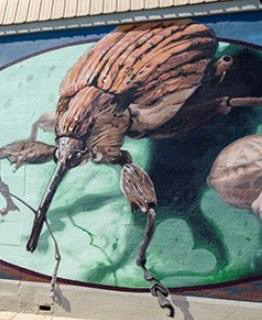
A weevil peers from a wall in Enterprise.
The community has more than two dozen statues that various sponsors decorate and place at different outdoor locations. It’s common here for people to go weevil hunting and take pictures with the statues. So my family, too, started taking pictures of them, and then we learned why the boll weevil is so important to the history of this town.
This part of the country was historically known for agriculture, and cotton was the main crop. In fact, in 1892 cotton was virtually the only cash crop from Georgia to Texas. Then in the late 1800s and early 1900s, this insect, which feeds on cotton buds and flowers, came into the United States from the interior of Mexico. It was not native to our country. American farmers had no defenses against it, and it devastated cotton crops throughout the south.
In Enterprise, it brought financial distress to the entire community. Then one farmer, who had a friend who raised peanuts, thought he’d give that a try. He bought some seed peanuts and did all right. The farming community wasn’t initially impressed with the idea of planting peanuts, but it quickly caught on as a viable option.
In 1919, Coffee County, Ala., was the largest producer of peanuts in our country. That saved the community of Enterprise, and as an expression of thanks to the pest that inspired that crop diversification, its citizens erected what may be the first monument ever known to an insect: The boll weevil!
A Boll Weevil Gallery:

DW Weevil at work outside Woodall Heating and Cooling.
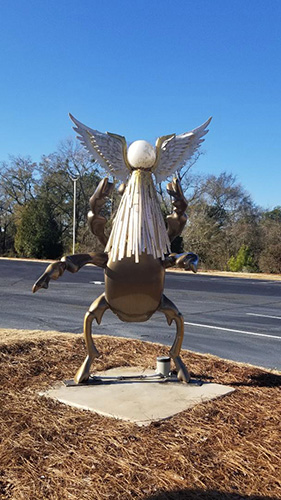
A weevil holds up the Angel of Light at Sorrells Funeral Home and Crematory.
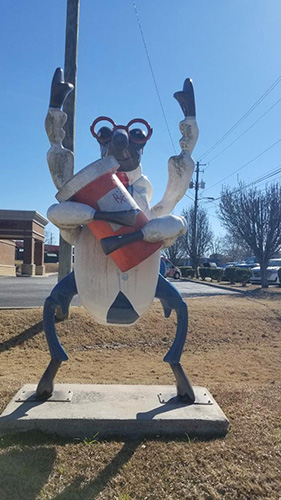
At Bryan Pharmacy, a weevil dispenses smiles and prescriptions.
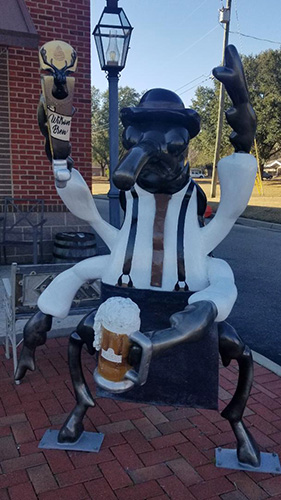
Wilson the WOAH Weevil at the White Oak Ale House.
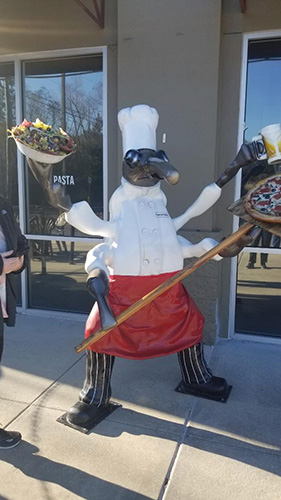
Chef Al Fredo at the Brick Pub and Pizzeria.

Super Weevil welcomes children at the Enterprise Pediatric Clinic.
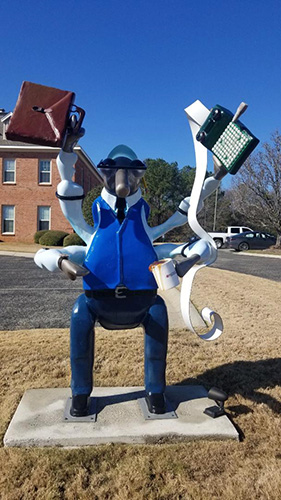
Abacus Weevil at Brunson, Wilkerson, Bowden & Associates, an accounting firm.

Ronald McWeevil at … where else?
Who Is This?
Photos and article by Becky Colwell

Unusual creepy-crawly in my entryway,
having eight legs and claws that resemble a scorpion.
I recently found this unusual looking creepy-crawly in my entryway. I hurried to grab my camera and took a picture, then captured the creature in my bug container to release outside. I rarely kill an arthropod, as 99 percent are beneficial, and the other 1 percent are food for someone else. Research is what Master Gardeners do, so I did some. I could see that it had eight legs, so arachnid. The pincer-like claws led me to think scorpion, but it had no tail. After more in-depth research on scorpions, I found out it is a pseudoscorpion
Pseudoscorpions are very small arachnids. They have eight legs, a flat, pear-shaped body, and pincer-like pedipalps that resemble those of scorpions. The body color can be yellowish tan to dark brown. Adults can live for two to three years. Chelifer cancroides is the species most commonly found in homes.
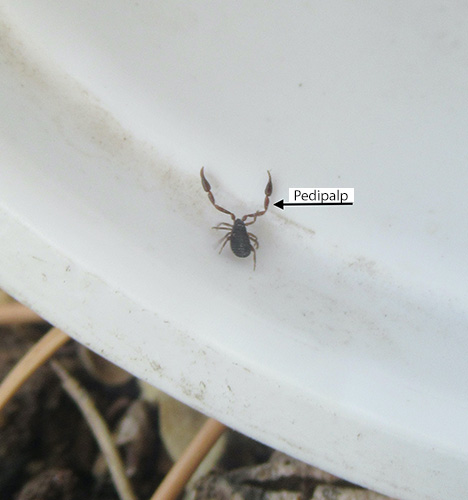
Observe the flat, pear-shaped body and pincer-like
pedipalps of this pseudoscorpion before being released outside.
Due to their small size (less than one-fifth of an inch, or three-eighths with pedipalps fully extended) and secretive nature, they are rarely seen, but they can be found in many environments. In homes they may be spotted in old books, where they eat booklice, or in bathroom sinks or tubs. Outside we would rarely see one, but they are busy feasting on many other small arthropods, including caterpillars, flies, ants, and beetle larvae.
Although pseudoscorpions pose no danger to homeowners, their presence may indicate a high level of humidity or a good food source. Pesticides are not recommended for control; if you spot one, just take it outside.
References
Jacobs, Steve, Senior Extension Associate, Penn State Extension, “Pseudoscorpions”. Reviewed January 2013, Updated June 2023.
Master Gardener Photos

Bleeding hearts. Springtime in Reno.
Photo by Shari Elena Quinn
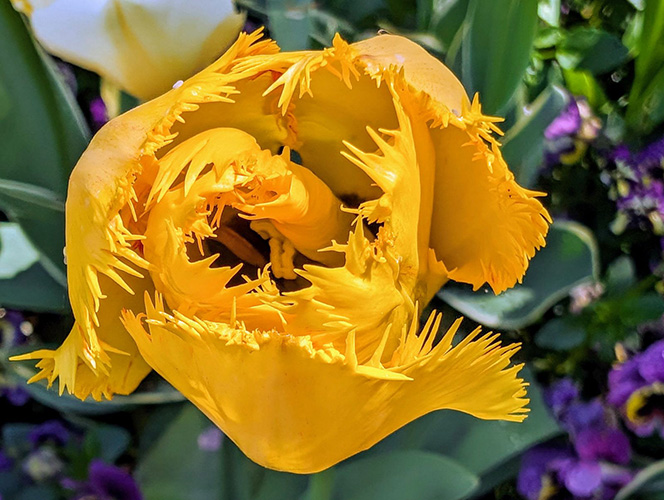
Fringed tulip species at Crystal Hermitage Tulip Watch.
Photo by Tricia Howarth
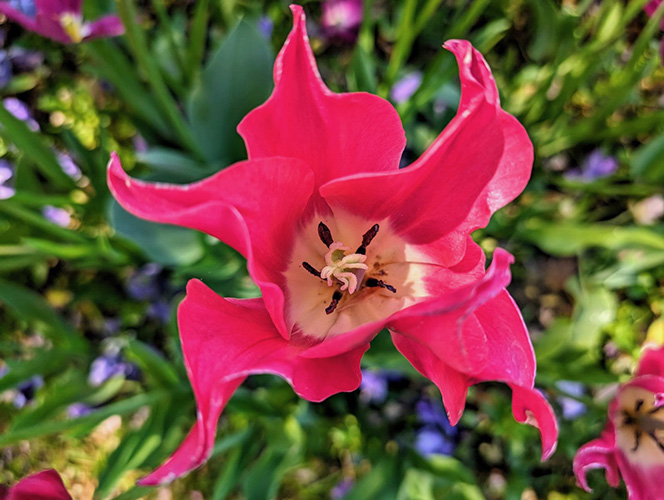
Unusual shaped petals of a tulip lily species at Crystal Hermitage Tulip Watch.
Photo by Tricia Howarth
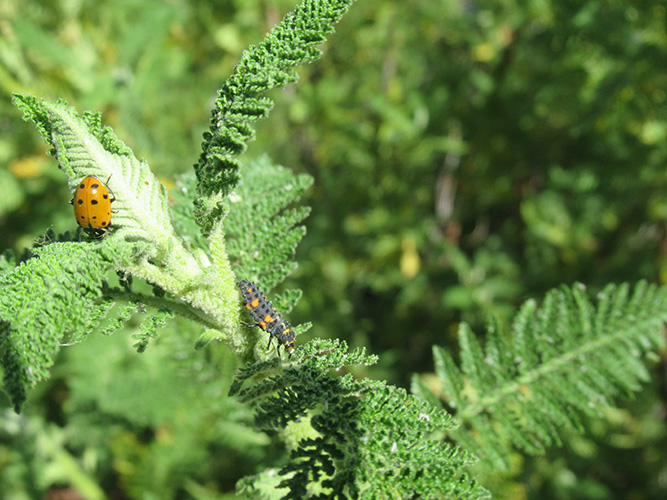
Adult lady beetle & larva eating white flies on fernbush.
Photo by Becky Colwell
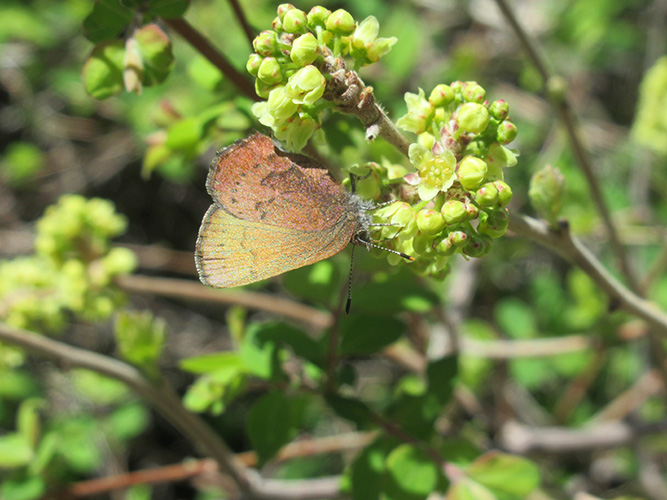
Brown elfin on gro low sumac.
Photo by Becky Colwell
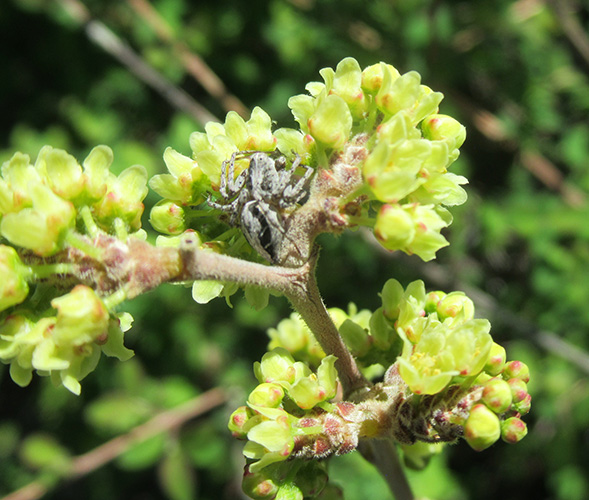
Jumping spider waiting for a meal on gro low sumac.
Photo by Becky Colwell
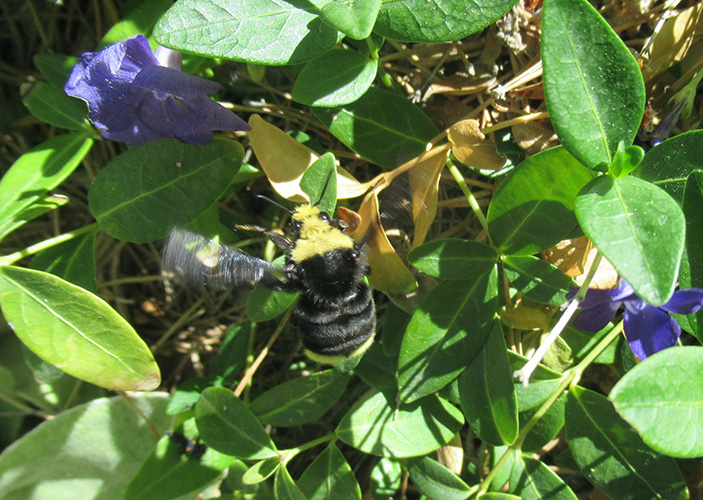
Queen bumble bee visiting vinca minor flowers.
Photo by Becky Colwell.
Gratitude
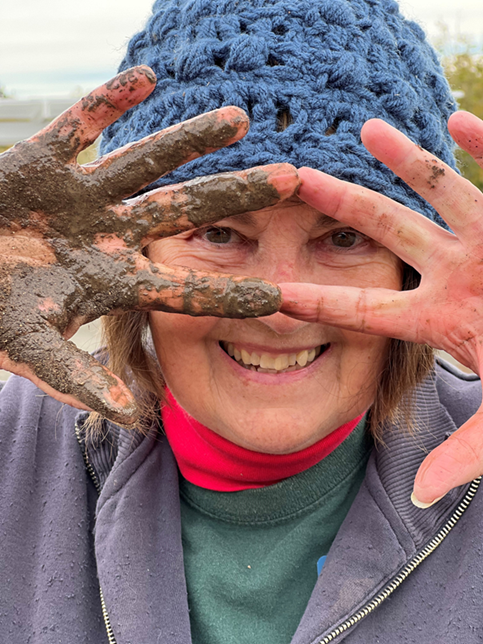
We have so much to be thankful for. The University of Nevada, Reno Extension Master Gardener Program is full of amazing volunteers who are committed to finding and providing scientifically based, university researched horticultural information for people in our community. We do a lot! We get to work with and volunteer with amazing people here in Washoe County.
We couldn’t do what we do, without the help and support of our community, our university and Extension partners and the amazing dedication of our Master Gardener Volunteers. Within our program we have some extra special volunteers known as Leads. They are the lead volunteers of various programs and activities. Leads are Master Gardeners that dedicate extra time to organize, plan, and execute tasks related to their project or activity. They do this by dedicating extra time to the program to lead and mentor our other Master Gardener volunteers to give them the resources and confidence to provide education to our community. They make a huge difference in our community and especially to the Master Gardener Program.
One such Master Gardener Lead Volunteer is Martha. Martha is one of our very first Leads here in Washoe County. She stepped up to be the Lead for the Master Gardener Teaching and Demonstration Garden located in the Community Garden at Rancho San Rafael Regional Park. Let’s take a minute to get to know Martha from a recent interview:
Interview with Martha McRae Master Gardener Lead Teaching & Demonstration Gardens:
- What sparked your interest in gardening?
- I’m old, I remember the victory gardens from WW2 as something my family did, and I have gardened all my life.
- What is your gardening passion?
- I removed a lot of my lawn and put in a xeric scape, before I became a Master Gardener. I think more people in the community could use alternative ways to garden in the desert. It is important given the water situation we have in the west.
- How has the Master Gardener Program scientifically helped you in your garden?
- I did a lot of research before I became a Master Gardener; the main thing is a better understanding of insects and systematic use of pesticides. Many people think MIB (more is better) and it is not.
- What makes you smile about the Master Gardener Program?
- The people I work with consistently. They are very supportive of our efforts! They make me smile, I am usually grumpy, they make me smile.
- Share a meaningful Master Gardener volunteer experience.
- After parties at Rancho, it helps us cool down after a hard day in the garden before we go to our hot cars and allows us to connect and work on relationships
- One word to describe the Master Gardener Program.
- Informative
- The Master Gardener program could not function without the help of MG Leads. What inspired you to become a Lead?
- Sometimes you really love doing something so much you want to step up and help other people get excited about it. To get people excited about it you must be invested in it yourself.
- Describe the program you Lead and how it impacts the community.
- The program is the Teaching and Demonstration Gardens that are in a Community Garden at a reginal park. There are community garden beds, we serve as help to identify issues, planting compatibility and so on. It is also a public park where we show different types of gardening, and we also grow food to donate to the Reno Sparks Gospel Mission. That is one of the reasons why some of the folks work so hard in our garden, because it is serving folks less fortunate in our community. We have the teaching aspect of the garden, with casual conversations and formal teaching events.
- What has been your greatest challenge as a Lead?
- I don’t get the same group of people showing up every week, every time a new person comes on board there is a new orientation process. People tend to look to me for all the answers and direction and it takes a while before people are comfortable working independently. This slows the process down, but my hope is that they all come back the following year.
- What has been your greatest joy as a Lead?
- I think at the end of the season, seeing all we have been able to accomplish as a team. A great sense of accomplishment for food insecurity and I am always hopeful the people will be able to implement the things they learn.
- What would like to see next for your program?
- The budget is always a big deal. I wish we had more funding to buy supplies. Things like chicken wire and shade cloth that would last several seasons. Irrigation is always an issue as well. We also would really like an events board, like they have at campgrounds, so we could post educational information like what weeds are growing, what insects are in the garden, what gardening techniques we are using and upcoming educational talks.
- If someone is thinking about becoming a Master Gardener, what would you tell them?
- I would advise them not to be working full-time. Part-time is fine, but it would be a challenge to do everything if you are working full-time to meet your recertification requirements. There is so much they could miss. Also, they should look inward and know if they just want the learning or if they want to work with the public. Volunteering and giving back to the community is what we do.
Martha is in the second year of being a Lead at the Master Gardener Teaching and Demonstration Gardens. This season Master Gardener Chris Dolittle has joined her as co-lead to help the program and activities grow and be more effective. We couldn’t do what we do without them.
The Master Gardener Program is so grateful to you both!
Questions or comments?
Reach out to us!
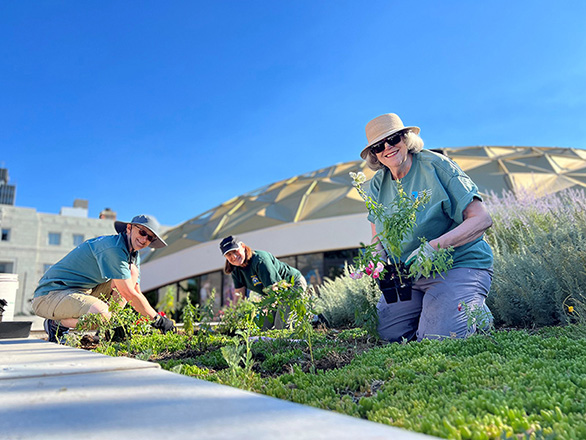
Help Desk Hours: 9 a.m. - 4 p.m. Tuesdays, Wednesdays & Thursdays
Phone: 775-784-4848
Email: mastergardeners@unce.unr.edu
Rachel McClure Master Gardener Coordinator
Phone: 775-336-0274
Email: rmcclure@unr.edu
How to become a Master Gardener
WASHOE COUNTY MASTER GARDENER EVENTS
MASTER GARDENER HELP DESK
Facebook


